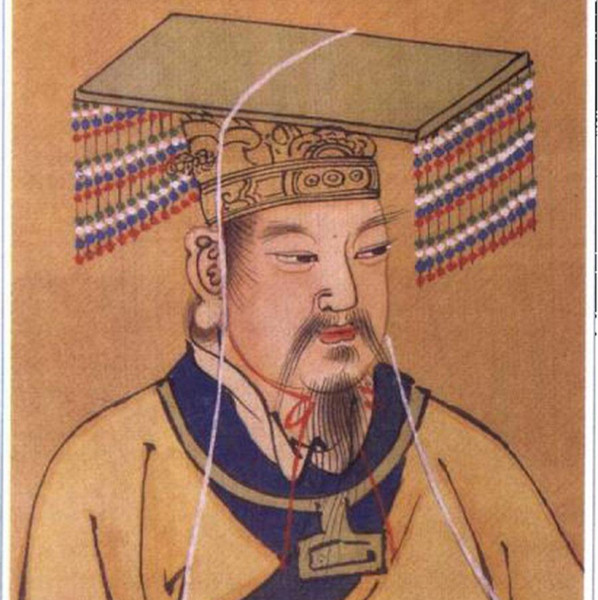 |
|
A portrait of the Yellow Emperor [File photo] |
Every nationality has its legendary era, and the Yellow Emperor (Huang Di) is a prime sovereign and cultural hero of China’s remote antiquity. Venerated as chieftain of a union of primitive tribes, the Yellow Emperor was born in Xuanyuan Hillock (present-day Xinzheng in Henan Province). He is hence also known as Xuanyuan and the Xuanyuan Yellow Emperor, the first monarch in history to unify the Chinese nation. This ancient ruler personifies the merits of his subjects and their many inventions, having developed production and so created the Chinese civilization. He is regarded as the earliest ancestor of the Chinese nation.
Many folk legends and historical records feature the Yellow Emperor, but films and television programs about his era are few. In April 2013, shooting of the animated TV series The Huang Di Epic began in Zhengzhou, capital city of Henan Province. It was jointly produced by Henan Multicultural Media Co., Ltd. and Beijing Glorious Animation Company of China International Television Corporation. The main theme of the series is primitive tribes’ transition from divergence and confrontation to unification and coalescence. It tells of the Yellow Emperor’s legendary life and how he united the entire nation in efforts to create a harmonious world.
New Interpretation of Historical Documents
According to legend, the Yellow Emperor was born more than 4,000 years ago, "...miraculously intelligent and able to speak once he was born," and lived along the Yellow River basin. At the age of 20 he was elected chieftain of the Youxiong tribe, and its primitive agriculture prospered. Later, the Youxiong forces gathered strength and steadily expanded their territories.
The first episode of the series, entitled "Unification of Six Tribes," tells of how the Yellow Emperor was apprenticed to a master, and displayed to the people a sense of responsibility. He endured numerous difficulties and dangers in his quest to find the Liuhe magic stone and to unify the six tribes of the Central Plain area. His role as supreme ruler thus began.
The second episode, entitled "The Yan and the Yellow Unite," tells of how the Yellow Emperor and Yan Emperor waged a "cold war" and a "hot war," but were eventually reconciled.
The Yan Emperor was chieftain of another tribe during the same historical period. He personally sampled more than 100 herbs and taught the people medicine and farming, so becoming known as Shennong, or the Holy Farmer. Towards the end of the late primitive society period two main tribes with common aims, at whose core were the Yellow Emperor and Yan Emperor, emerged. There followed a continuous synthesization that gradually formed the Huaxia nationality. This is why the Chinese people call themselves "descendants of Yan-Huang."
The third episode, entitled "A Harmonious World," tells of how the Yellow Emperor and Yan Emperor united to fight Chiyou, tribal leader of the Jiuli tribe, in the Zhuolu wilderness. The Banquan Battle between the Yellow Emperor and Yan Emperor and the Zhuolu Battle between the Yan-Yellow Emperors and Chiyou are major conflicts in world war history. They laid the foundation for the Chinese nation as a political community, as a community of common destiny, and as a cultural community. Having defeated Chiyou, the Yellow Emperor and Yan Emperor did not slaughter the Chiyou tribes, but gave Chiyou the posthumous title of "God of War" and assimilated the Chiyou tribes. They thus laid the foundation for the harmonious culture of the Chinese civilization.
The Chronicles of the Yellow Emperor of the Historical Records include the story of how the Yellow Emperor "teaches the six mythical fierce animals – the xiong, pi, pi, xiu, chu and hu – to fight the Yan Emperor in the Banquan wilderness," according to executive producer of the series and president of Henan Multicultural Media Co., Ltd., Zhang Zhenyu. Exactly what these fierce mythical animals looked like has remained a mystery for more than 2,000 years. To evoke vividly this period of history, The Huang Di Epic takes Juci Mountain, the core area of the Youxiong culture, as the coordinate origin. By combining historical records and mythology it synthesizes magnificent historical structure with romantic poetic fantasy. The series also names the tribes after the xiong, pi, pi, xiu, chu and hu beasts.
In portraying the social relations between the Yellow Emperor and these six tribes, and the gradual transition from war to peace between the Yan Emperor and Yellow Emperor, the TV series maps the historical process towards civilization. It deciphers the mystery of the amalgamation of the Huaxia tribes and celebrates the earliest ancestor Yellow Emperor’s great achievements. The production thus presents a multi-colored scroll painting of the beginnings of the Chinese nation, and an interpretation of the core Yellow Emperor culture values of "self-discipline, social commitment, inclusiveness and diligence."